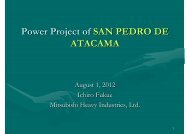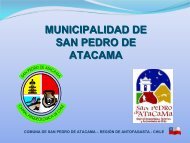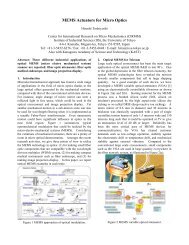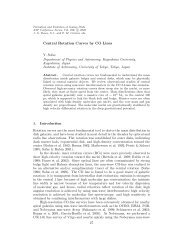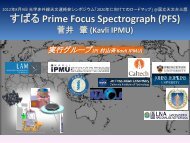Fabrication and tolerances of moth-eye structures for perfect ...
Fabrication and tolerances of moth-eye structures for perfect ...
Fabrication and tolerances of moth-eye structures for perfect ...
You also want an ePaper? Increase the reach of your titles
YUMPU automatically turns print PDFs into web optimized ePapers that Google loves.
Figure 1. (a) A schematic illustration <strong>of</strong> <strong>moth</strong>-<strong>eye</strong> structure. The transmittance depends on D <strong>and</strong> H. (b) The SEM<br />
image <strong>of</strong> the sample No. 1 taken right above the protuberances. (c) The side image <strong>of</strong> the sample No. 1. The flared<br />
shape is observed. The sample No.2 has a similar shape to that <strong>of</strong> No. 1. (d) The side image <strong>of</strong> the sample No. 3. The<br />
shape <strong>of</strong> the protuberances is straight.<br />
where n Si is the refractive index <strong>of</strong> silicon, <strong>and</strong> n Si ∼ 3.42. 3 This high reflectance arises from its extremely high<br />
refractive index. Antireflection is strongly needed <strong>for</strong> astronomical applications. Although there are many ways<br />
<strong>for</strong> antireflection, most <strong>of</strong> them cannot be applied to mid-infrared instruments. Muti-layer coating, <strong>for</strong> example,<br />
is one <strong>of</strong> the most popular ways to achieve antireflection but needs various kinds <strong>of</strong> materials, each having a<br />
different refractive index. In addition, multi-layer structure can be broken due to bimetal effect under cryogenic<br />
environment which is needed in order to suppress the thermal radiation from instruments. We there<strong>for</strong>e have<br />
difficulty in applying multi-layer coating. Another example is a sub-wavelength structure which consists <strong>of</strong> bulk<br />
<strong>and</strong> porous layers piled by turns. 4 It is suitable <strong>for</strong> antireflection but not easy to fabricate because it is necessary<br />
to pile many layers in order to achieve broadb<strong>and</strong> antireflection. A <strong>moth</strong>-<strong>eye</strong> structure is also one <strong>of</strong> effective<br />
<strong>structures</strong> <strong>for</strong> antireflection. This structure is a surface-relief structure which needs only one material. We think<br />
this structure is the best because it does not have problems mentioned above. We have designed <strong>moth</strong>-<strong>eye</strong><br />
<strong>structures</strong> on silicon <strong>for</strong> 25-40 µm.<br />
The <strong>moth</strong>-<strong>eye</strong> structure has many protuberances placed on a plane surface next to each other like Fig. 1(a).<br />
The protuberances have nearly a conical shape. A similar structure can be found on corneas <strong>of</strong> nocturnal insects,<br />
such as <strong>moth</strong>s, after which it is called <strong>moth</strong>-<strong>eye</strong> structure. Bernhard 5 showed that the <strong>structures</strong> on the corneas<br />
<strong>of</strong> <strong>moth</strong>s worked to suppress reflection by experiments using a model scaled up properly <strong>for</strong> microwave. In case<br />
<strong>of</strong> visible light, they have been applied to a surface on crystalline silicon <strong>for</strong> solar cells (e.g. Forberich et al. 6 ).<br />
Moth-<strong>eye</strong> <strong>structures</strong> on a GaAs substrate have been analyzed in detail in the near-infrared up to 17 µm. 7<br />
In this paper, 25-40 µm is the b<strong>and</strong> in which we would like to attain transmittance <strong>of</strong> more than 99 %<br />
<strong>for</strong> normal incidence. The next section includes how we have determined the design <strong>of</strong> the <strong>moth</strong>-<strong>eye</strong> structure<br />
<strong>and</strong> have fabricated them. In section 3, it is shown how we have made measurements <strong>and</strong> have corrected the<br />
measurements <strong>for</strong> getting precise transmittance. In section 4, the results <strong>of</strong> measurements after analysis are







